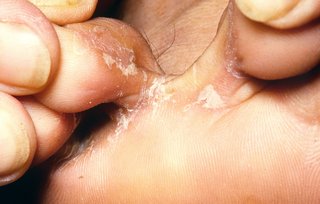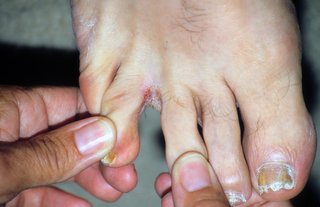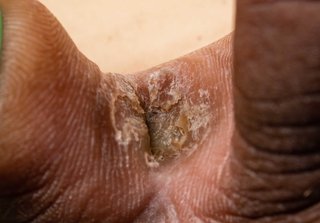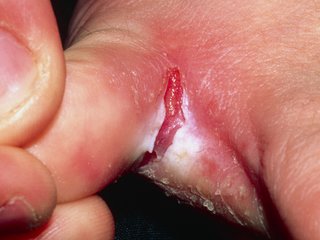Athlete's foot is a common fungal infection that affects your feet. You can usually treat it with creams, sprays or powders from a pharmacy, but it can keep coming back.
Symptoms of athlete's foot
One of the main symptoms of athlete's foot is itchy white patches between your toes.





Other symptoms
You can get athlete's foot on the soles or sides of your feet. You can also get fluid-filled blisters.
If athlete's foot is not treated, it can spread to your toenails and cause a fungal nail infection.
Causes of athlete's foot
Athlete's foot is a contagious condition.
You can get it by:
- walking barefoot where someone with athlete's foot has walked, such as in changing rooms and showers
- touching your foot against the affected skin of someone with athlete's foot
You're more likely to get it if you have wet or sweaty feet, or if you have broken skin on your feet.
Treatment for athlete's foot
It is unlikely that athlete's foot will get better on its own. But you do not usually need to see a GP.
Talk to your pharmacist if you think you have athlete's foot. They will tell you which antifungal medicine to use.
The medicine usually takes a few weeks to work. You can keep using some medicines to stop athlete's foot coming back.
It is important to keep your feet clean and dry.
Antifungal medicines
Antifungal treatments for athlete's foot are available as:
- creams
- sprays
- powders
They're not all suitable for everyone. For example, some are only for adults. Always check the packaging or ask a pharmacist.
You might need to try a few treatments to find one that works best for you.
Non-urgent advice: Speak to a GP if:
- treatments from a pharmacy do not work
- your foot is red, hot and painful - this could be a more serious infection
- you have diabetes - foot problems can be more serious
- you have a weakened immune system - for example following an organ transplant
Further tests
Your GP may take a small sample of your affected skin cells.
The sample will be sent to a laboratory to find out what type of fungus is causing your infection. This will help them decide the best treatment. Your GP may prescribe a steroid cream and antifungal tablets.
They may also refer you to a skin specialist (dermatologist) for more tests and treatment.
Things you can do yourself
There are things you can do yourself to treat athlete's foot and stop it returning:
Do
-
dry your feet after washing them, particularly between your toes
-
pat your feet dry instead of rubbing them
-
use a separate towel for your feet and wash it regularly
-
take your shoes off when at home
-
wear clean socks every day - cotton socks are best
Don't
-
do not scratch affected skin - this can spread it to other warm moist areas such as your armpit
-
do not walk around barefoot - wear flip-flops in places like changing rooms and showers
-
do not share your towels, socks or shoes
-
do not wear shoes that make your feet hot and sweaty
Follow this advice even after finishing treatment. This will help stop athlete's foot coming back.
Content supplied by the NHS and adapted for Ireland by the HSE
